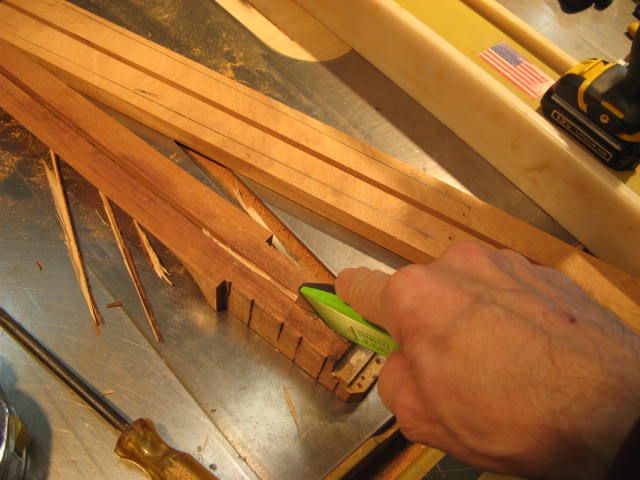boogieongtr
Active member
- Joined
- May 16, 2006
- Messages
- 938
To help pass the time I thought I'd post a headstock repair I did several years ago. Here's a 52 I bought that had the headstock repaired several times in the past. The guitar wouldn't hold tension and snapped off when I tried to tune it up.


After stripping off the finish you can see the screws and nails and how many times it was glued together.


The wood was rotted so I decided to make a new headstock. I came up with a process that would allow me to use jigs and fixtures I have in the shop. The key would be to come up with a way to hold the neck at a 90 degree angle so I could move from machine to machine. I used a 2-1/4" piece of mahogany that we'll call the "sled". You will see how important the sled becomes as I start the process.

First I used a heat blanket and removed the fingerboard. Next I needed to remove the truss rod. I found center line on the sled and used a 3/16" dado and made the cut leaving solid wood on both ends of the sled so it doesn't collapse. Attach the neck using double sided tape to the sled so I can remove the maple spline to get to the truss rod.

Most of the maple spline is removed.

With a razor blade I'll remove the rest of the maple spline.

With the maple spline removed the truss rod comes right out.



After stripping off the finish you can see the screws and nails and how many times it was glued together.


The wood was rotted so I decided to make a new headstock. I came up with a process that would allow me to use jigs and fixtures I have in the shop. The key would be to come up with a way to hold the neck at a 90 degree angle so I could move from machine to machine. I used a 2-1/4" piece of mahogany that we'll call the "sled". You will see how important the sled becomes as I start the process.

First I used a heat blanket and removed the fingerboard. Next I needed to remove the truss rod. I found center line on the sled and used a 3/16" dado and made the cut leaving solid wood on both ends of the sled so it doesn't collapse. Attach the neck using double sided tape to the sled so I can remove the maple spline to get to the truss rod.

Most of the maple spline is removed.

With a razor blade I'll remove the rest of the maple spline.

With the maple spline removed the truss rod comes right out.











































